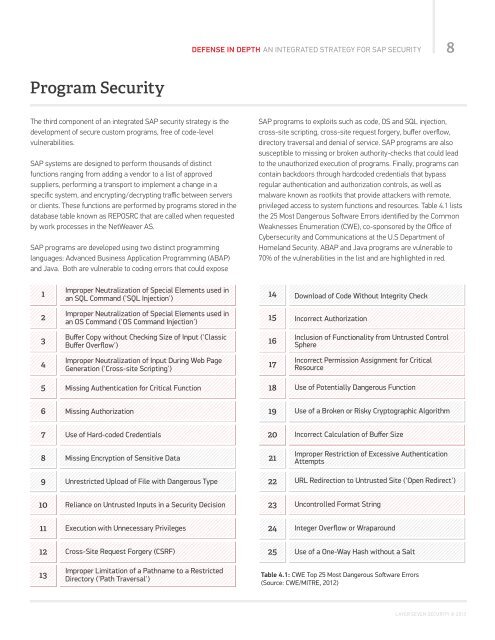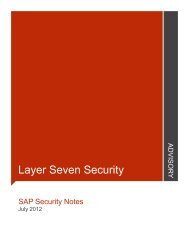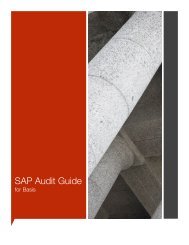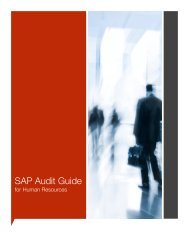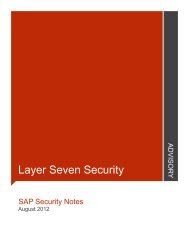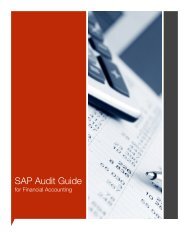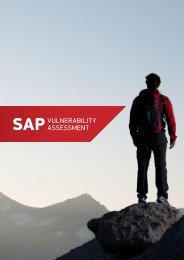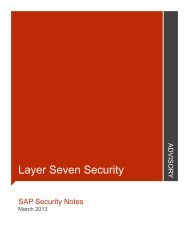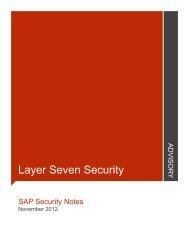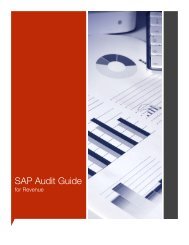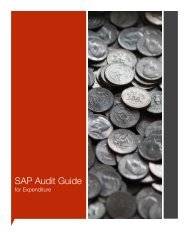DEFENSE IN DEPTH - Layer Seven Security
DEFENSE IN DEPTH - Layer Seven Security
DEFENSE IN DEPTH - Layer Seven Security
Create successful ePaper yourself
Turn your PDF publications into a flip-book with our unique Google optimized e-Paper software.
<strong>DEFENSE</strong> <strong>IN</strong> <strong>DEPTH</strong> AN <strong>IN</strong>TEGRATED STRATEGY FOR SAP SECURITY 8Program <strong>Security</strong>The third component of an integrated SAP security strategy is thedevelopment of secure custom programs, free of code-levelvulnerabilities.SAP systems are designed to perform thousands of distinctfunctions ranging from adding a vendor to a list of approvedsuppliers, performing a transport to implement a change in aspecific system, and encrypting/decrypting traffic between serversor clients. These functions are performed by programs stored in thedatabase table known as REPOSRC that are called when requestedby work processes in the NetWeaver AS.SAP programs are developed using two distinct programminglanguages: Advanced Business Application Programming (ABAP)and Java. Both are vulnerable to coding errors that could exposeSAP programs to exploits such as code, OS and SQL injection,cross-site scripting, cross-site request forgery, buffer overflow,directory traversal and denial of service. SAP programs are alsosusceptible to missing or broken authority-checks that could leadto the unauthorized execution of programs. Finally, programs cancontain backdoors through hardcoded credentials that bypassregular authentication and authorization controls, as well asmalware known as rootkits that provide attackers with remote,privileged access to system functions and resources. Table 4.1 liststhe 25 Most Dangerous Soſtware Errors identified by the CommonWeaknesses Enumeration (CWE), co-sponsored by the Office ofCybersecurity and Communications at the U.S Department ofHomeland <strong>Security</strong>. ABAP and Java programs are vulnerable to70% of the vulnerabilities in the list and are highlighted in red.1Improper Neutralization of Special Elements used inan SQL Command ('SQL Injection')14Download of Code Without Integrity Check2Improper Neutralization of Special Elements used inan OS Command ('OS Command Injection')15Incorrect Authorization3Buffer Copy without Checking Size of Input ('ClassicBuffer Overflow')16Inclusion of Functionality from Untrusted ControlSphere4Improper Neutralization of Input During Web PageGeneration ('Cross-site Scripting')17Incorrect Permission Assignment for CriticalResource5Missing Authentication for Critical Function18Use of Potentially Dangerous Function6Missing Authorization19Use of a Broken or Risky Cryptographic Algorithm7Use of Hard-coded Credentials20Incorrect Calculation of Buffer Size8Missing Encryption of Sensitive Data21Improper Restriction of Excessive AuthenticationAttempts9Unrestricted Upload of File with Dangerous Type22URL Redirection to Untrusted Site ('Open Redirect')10Reliance on Untrusted Inputs in a <strong>Security</strong> Decision23Uncontrolled Format String11Execution with Unnecessary Privileges24Integer Overflow or Wraparound12Cross-Site Request Forgery (CSRF)25Use of a One-Way Hash without a Salt13Improper Limitation of a Pathname to a RestrictedDirectory ('Path Traversal')Table 4.1: CWE Top 25 Most Dangerous Soſtware Errors(Source: CWE/MITRE, 2012)LAYER SEVEN SECURITY © 2013


